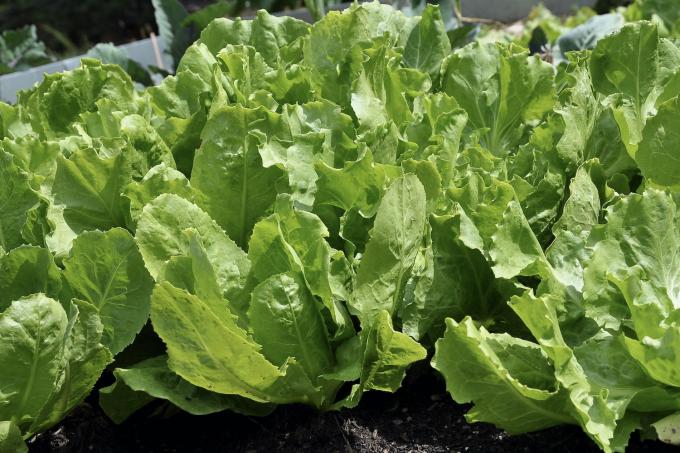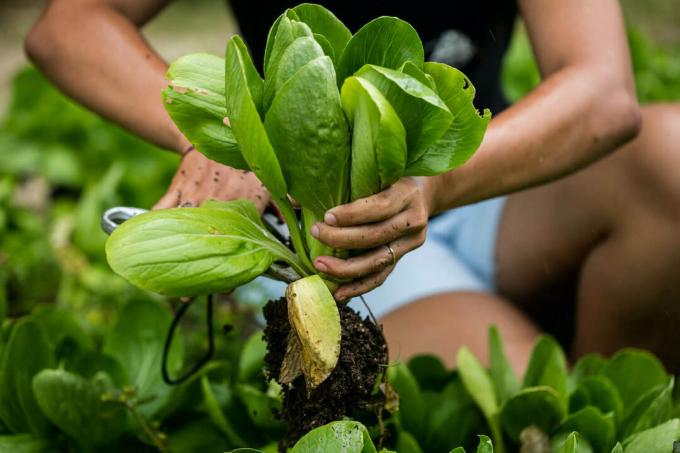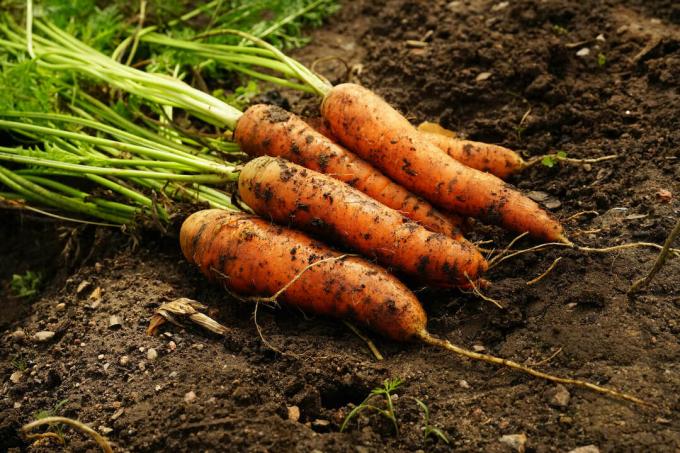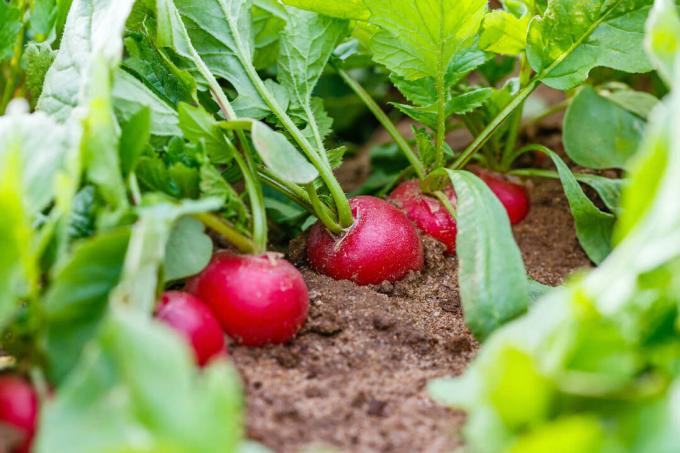Autumn is here and with it ten great types of vegetables that thrive in the bed even in stormy weather and colder temperatures.

The summer harvest is slowly coming in, the beds are getting emptier and winter is getting closer. For many gardeners, autumn is already the end of the gardening season. It can only really get going in autumn. Countless types of vegetables are ready to move into the bed and use the last warm days before winter. We will show you ten types of vegetables that are particularly worth growing in the fall.
contents
- 1. Grow lettuce in the fall
- 2. Growing pak choi in the fall
- 3. Grow cauliflower in the fall
- 4. Grow turnips in the fall
- 5. Growing chard in the fall
- 6. Grow carrots in the fall
- 7. Growing beets in the fall
- 8. Growing radishes in the fall
- 9. Growing kale in the fall
- 10. Grow spinach in the fall
1. Grow lettuce in the fall
Isn't lettuce a typical spring and summer vegetable? Not only, the lettuce is also wonderful for cultivation in autumn. Sown until the end of August, the plants also grow outside without any problems. Endive or frisée lettuce have proven to be particularly good for autumn cultivation, but also classics such as lettuce or
Lamb's lettuce find their place in the autumn bed. In fact, there are even advantages to growing in the fall: the lower temperatures minimize the risk of the lettuce “shooting”, i.e. starting to bloom.
2. Growing pak choi in the fall
The one from Asia Pak choi (Brassica rapa subsp. chinensis) is not only healthy and tasty, but (like almost all types of cabbage) is also perfect for growing in the fall. For the Outdoor Pak Choi cultivation August or early September is best, preferably when the hottest days have passed. Asian vegetables do not tolerate too much heat and quickly start to shoot. The Pak Choi is then ready for harvest just six to eight weeks after sowing.

3. Grow cauliflower in the fall
Also a cabbage and therefore well suited for autumn is the cauliflower (Brassica oleracea var. botrytis). Since the cauliflower is particularly susceptible to pests in summer, the Cauliflower Cultivation in autumn even more productive. Start cultivating seeds indoors as early as August, as the journey to the ready-to-plant seedling can take around 30 days. The plant then finds its way into the bed in the first week of September. the Cauliflower Harvest can take place well into October, about eight to twelve weeks after sowing.

4. Grow turnips in the fall
Although not so popular anymore, the swede (Brassica napus supp. rapifera) to the classic winter vegetables. No wonder, after all, the swede is not only extremely robust, but also tolerates frosts down to -6°C. The swedes should be in the bed at least eight weeks before the first frost, but sowing at the end of July or beginning of August is best. Depending on the time of cultivation, the swedes can be harvested from September, but at the latest before the first, longer frost period.
tip: For an aromatic harvest and healthy plants, it pays to use a quality organic soil. Our peat-free is recommended for vegetables Organic tomato & vegetable soil.
5. Growing chard in the fall
chard (Beta vulgaris subsp. vulgaris) is not only very tasty, but also very robust – chard therefore tolerates light and medium frosts without any problems. the Swiss chard seed should be carried out by the beginning of August at the latest so that the plant can develop sufficiently before the onset of winter. Incidentally, Swiss chard grows particularly well as a follow-up culture to peas or beans, as these store valuable nitrogen in the soil. Stick chard can be harvested after ten to twelve weeks, leaf chard even after eight weeks. In mild regions, a thick layer of mulch from leaves can get the chard through the winter unscathed - so it can be harvested again in spring.

6. Grow carrots in the fall
Also the carrots (Daucus carota subsp. sativus) are probably better known to us as vegetables from spring and summer. In fact, the orange roots can be grown almost all year round - who in autumn and If Winter doesn't want to do without his crunchy carrots, simply sow the carrots again in the August out. But not only the supply of fresh carrots throughout the year is an advantage of autumn sowing: they also taste late harvested carrots sweeter than their springtime comrades. The reason for this is that the carrot starts converting its starch into sugar in cold temperatures.

7. Growing beets in the fall
Whether red, white or yellow, the Beetroot (Beta vulgaris subsp. vulgaris) is a classic vegetable that everyone probably knows from grandma's kitchen. The last time for a Sowing the beetroot is mid-August, after all, the beetroot needs some time to develop its delicious tuber. Just before the first frost, as soon as the leaves start to spot, the beets are ripe. the Beetroot Harvest is now possible, the turnips can be dug up. What is particularly practical about the beetroot is that it can be easily stored in winter. Packed in boxes without their leaves in a dark, cool place, the bulbs will easily last into the following spring.

8. Growing radishes in the fall
Even radish (Raphanus sativus subsp. sativus) belong to the late bloomers – they last until September Radish sowing easily possible outdoors. However, you should note a few differences to growing radishes in spring and summer: Choose a fast-growing one radish variety, so that the vegetables are also ready for harvest in autumn. Ideally, you can harvest the radishes after just four weeks. And instead of a place in the semi-shade like in summer, the radish prefers a sunny spot in autumn where it gets enough light. So they thrive in autumn without much effort.

9. Growing kale in the fall
Kale (Brassica oleracea var. sabellica) is and remains the number one winter vegetable. It is therefore not surprising that the vitamin C bomb finds its way into the home garden quite late. However, the kale should be sown in August at the latest. But otherwise he is Kale cultivation the perfect choice for autumn: the vegetable is persistent, robust and only slightly disease-prone. It is also very frost-resistant and can be harvested throughout the winter. Many gardeners even swear by not harvesting kale until after the first frost. The reason for this: The frost reduces the bitter substance content in the leaves and the plant tastes twice as good. More to Harvesting kale find out in this article.

10. Grow spinach in the fall
spinach (Spinacia oleracea) does not tolerate one thing in particular: heat! So what could be better than that Spinach seed to do in the cool autumn? For harvest in autumn and winter, spinach can be sown from the end of August to the beginning of October. The first leaves can be harvested after just six to eight weeks. Since spinach is very frost-tolerant, nothing stands in the way of a harvest in winter and the spinach provides us with many healthy vitamins and its delicious taste.

Even if some types of vegetables can still be grown in autumn, the gardening season is slowly coming to an end. With a green manure in autumn However, you can already make preparations for next year. You can read what this is all about in our article.

